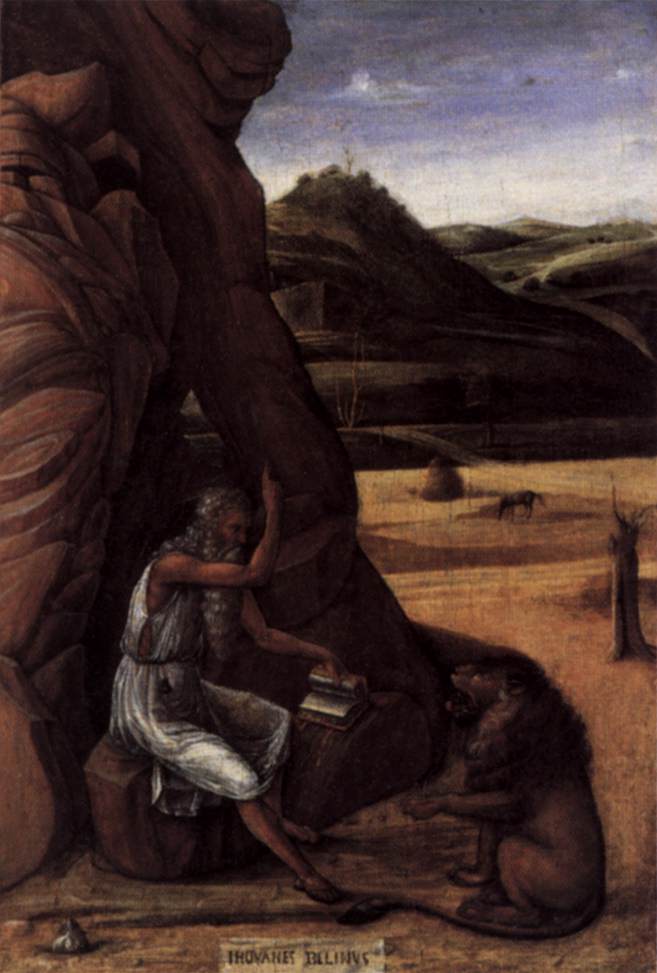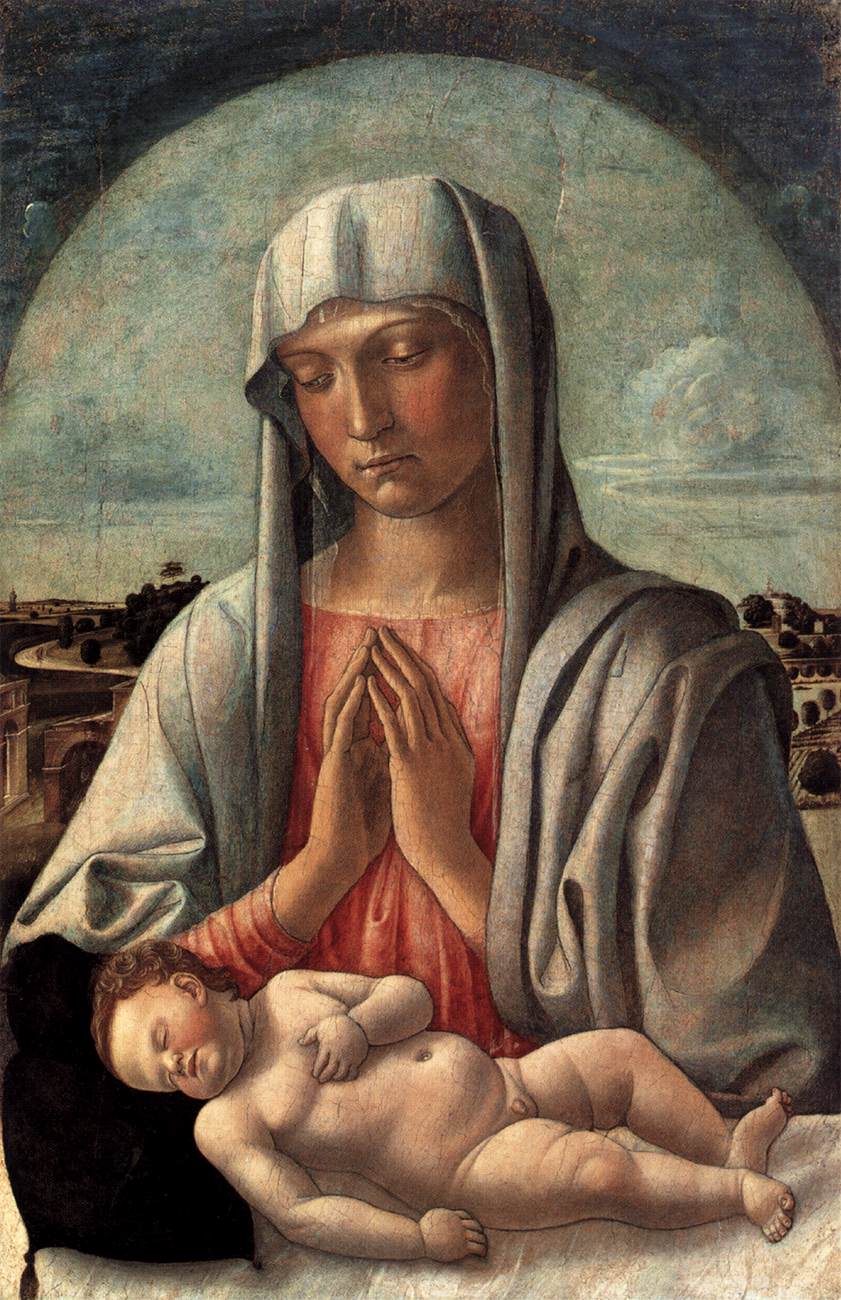(b. ca. 1426, Venezia, d. 1516, Venezia) |
Dr.Lal RatnakarBiography Venetian painter, founder of the Venetian school of painting, Giovanni Bellini raised Venice to a center of Renaissance art that rivaled Florence and Rome. He brought to painting a new degree of realism, a new wealth of subject-matter, and a new sensuousness in form and color. Giovanni Bellini was born in Venice, Italy. Little is known about his family. His father, Jacopo, a painter, was a pupil of one of the leading 15th-century Gothic revival artists. Giovanni and his brotherGentile probably began their careers as assistants in their father's workshop. In his early pictures, Bellini worked with tempera, combining a severe and rigid style with a depth of religious feeling and gentle humanity. His first phase as an artist was strongly influenced by his formidable brother-in-law, the Paduan painter Andrea Mantegna, from whom he took a sculpturesque figure style; a sense for the potential eloquence of contour line; and occasional compositional ideas, as in the early Agony in the Garden (1460s, National Gallery, London), which was the first of a series of Venetian landscape scenes that continued to develop for the next century. Four triptychs in the Venice Accademia and two Pietàs, both in Milan, are all from this early period. Bellini's St. Vincent Ferrer altarpiece, which is still in the church of Santi Giovanni e Paolo in Venice, was painted in the mid-1470s. The personal components of Bellini's style, which became fundamental to the character of Venetian Renaissance painting as a whole, found expanded scope and an altered form in his painting of the 1470s. Flemish painting and, in 1475, Antonello da Messina's paintings, showed Bellini the possibilities of the oil medium, which he used from then on in place of tempera. His color took on added depth, and he explored the interactions of color, light, air, and substance still more fully. As a result, the distinction between solids and space became less clear; air began to mediate between them; contour lines gradually disappeared, to be replaced by transitions of light and shadow. Saint Francis (1480?, Frick Collection, New York City) represents an early stage in this process. The process is well advanced in two dated pictures of the 1480s: Madonna of the Trees (1487, Accademia, Venice) and Madonna with Saints (1488, Church of the Frari, Venice). In 1479 Bellini took his brother's place in continuing the painting of great historical scenes in the Hall of the Great Council in Venice. During that year and the next he devoted his time and energy to this project, painting six or seven new canvases. These, his greatest works, were destroyed by fire in 1577. The Saint Francis also represents an important innovation of Bellini's in these years—paintings in which mood and meaning are conveyed at least as much by landscape as by figures. In the landscapes themselves, he combined a Flemish-inspired minuteness of brilliantly rendered detail with an Italian grasp of general principles as no previous artist had done. Equally significant in setting precedents was a series of monumental altarpieces portraying the Madonna enthroned among saints. In these, figures, space, light, architecture, and sometimes landscape were balanced with seemingly effortless perfection to achieve a complex but harmonious image of serene grandeur. Such paintings as, for example,Madonna with Doge Agostino Barbarigo (1488, Santa Pietro Martire, Murano), are pioneer exemplars of the High Renaissance style. The latest of the series, Madonna with Saints (1505, San Zaccaria, Venice), typifies Bellini's late style. Complex modulations of color establish a mellow overall tone within which the figures, their surroundings, light, and air seem inseparable—merely different aspects of a single identity. Forms are ample but less dense than before; paint is delicately applied to give their edges and surfaces a hazy indistinctness. The Feast of the Gods (1514, National Gallery, Washington, D.C.), the landscape of which was devised by Titian, shows Bellini, still flexible and inventive in his 80s, turning to classical and pagan subject matter shortly before his death in 1516 in Venice. At the end of his career Bellini became one of the greatest landscape painters. His ability to portray outdoor light was so skillful that the viewer can tell not only the season of the year but also almost the hour of the day. Bellini lived to see his own school of painting achieve dominance and acclaim. His influence carried over to his pupils, two of whom became better known than he was: Giorgione (1477?-1510) and Titian (1488?-1576). His younger contemporary, the German painter Albrecht Durer, wrote of Bellini in 1506: "He is very old, and still he is the best painter of them all." Bellini died in Venice in 1516. Bellini's historical importance is immense. In his 65-year evolution as an artist, he brought Venetian painting from provincial backwardness into the forefront of Renaissance and the mainstream of Western art. Moreover, his personal orientations predetermined the special nature of Venice's contribution to that mainstream. These include his luminous colorism, his deep response to the natural world, and his warm humanity. ------------------------------------------- Works Paintings until 1459 by Giovanni BELLINI  St Jerome in the Desert c. 1450 Egg tempera on wood, 44 x 23 cm Barber Institute of Fine Arts, Birmingham  Madonna with Child 1450-55 Tempera on wood, 47 x 31,5 cm Civico Museo Malaspina, Pavia  Madonna and Child c. 1455 Tempera on panel, 72 x 46 cm Metropolitan Museum of Art, New York |
मंगलवार, 12 अक्टूबर 2010
BELLINI, Giovanni
सदस्यता लें
टिप्पणियाँ भेजें (Atom)
ब्लॉग आर्काइव
-
▼
2010
(59)
-
▼
अक्टूबर
(13)
- मिटटी के रंग
- REMBRANDT Harmenszoon van Rijn
- SENIORITY LIST AS ON 01-07-2011-DRAWING & PAINTING
- El Greco
- RUBENS, Pieter Pauwel
- Uchchhisht-Umarao Singh Jatav
- DYCK, Sir Anthony van
- DÜRER, Albrecht
- BELLINI, Giovanni
- Titian's-TIZIANO Vecellio
- Raphael (RAFFAELLO Sanzio)
- LEONARDO da Vinci
- MICHELANGELO Buonarroti
-
▼
अक्टूबर
(13)
मेरे बारे में

- चित्रकला
- GHAZIABAD, Uttar Pradesh, India
- कला के उत्थान के लिए यह ब्लॉग समकालीन गतिविधियों के साथ,आज के दौर में जब समय की कमी को, इंटर नेट पर्याप्त तरीके से भाग्दौर से बचा देता है, यही सोच करके इस ब्लॉग पर काफी जानकारियाँ डाली जानी है जिससे कला विद्यार्थियों के साथ साथ कला प्रेमी और प्रशंसक इसका रसास्वादन कर सकें . - डॉ.लाल रत्नाकर Dr.Lal Ratnakar, Artist, Associate Professor /Head/ Department of Drg.& Ptg. MMH College Ghaziabad-201001 (CCS University Meerut) आज की भाग दौर की जिंदगी में कला कों जितने समय की आवश्यकता है संभवतः छात्र छात्राएं नहीं दे पा रहे हैं, शिक्षा प्रणाली और शिक्षा के साथ प्रयोग और विश्वविद्यालयों की निति भी इनके प्रयोगधर्मी बने रहने में बाधक होने में काफी महत्त्व निभा रहा है . अतः कला शिक्षा और उसके उन्नयन में इसका रोल कितना है इसका मूल्याङ्कन होने में गुरुजनों की सहभागिता भी कम महत्त्व नहीं रखती.

कोई टिप्पणी नहीं:
एक टिप्पणी भेजें